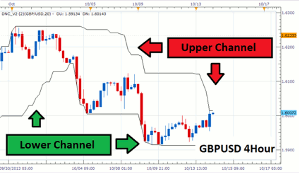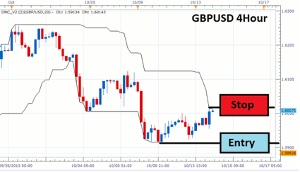The forex market is known for its strong trends, which can make trading a breakout strategy an effective approach to the markets, writes Walker England of DailyFX.com.
Normally the first step of any breakout strategy is to identify the key levels of support and resistance for a currency pair. Today we are going to review using Donchian Channels for just that purpose, while completing a trading setup on the GBP/USD. Let’s get started!
GBP/USD Price Channels

(Created using FXCM’s Marketscope 2.0 charts)
Click to Enlarge
Trading Donchian Channels
Donchian channels can be applied to any chart to extrapolate current levels of support and resistance. They do this by clearly identify the high and low on a graph created during the selected number of periods. Above we can see the Donchian channels applied to a GBP/USD four-hour chart, using a 20-period setting. The channel lines highlight the current 20 periods high and low values, which can be used as support and resistance when trading breakouts. Breakout traders in a downtrend will look for price to break below the lower channel prior to creating new entries in the direction of the trend. The same is true in an uptrend, where traders will identify the upper channel as a potential area to enter the market.
Since the price of the GBP/USD has declined as much as 346 pips for the month of October, many traders will want to identify new entries to sell the pair on a breakout towards lower lows. With our current low already identified by the Donchian channels at 1.5913, traders can begin preparing for a breakout below this value. As pictured below, you can find a sample breakout setup. Entry orders to sell the GBP/USD can be placed at a minimum of one pip below support, so traders enter the market on a breakout to lower lows.
GBP/USD Four-Hour Breakout

(Created using FXCM’s Marketscope 2.0 charts)
Click to Enlarge
Setting Risk
As with any strategy, breakout traders should incorporate stops into their trading. When using Donchian channels, this process can be made very easy. Remember how the top pricing channel (representing the 20-period high), acts as an area of resistance? In a downtrend, price is expected to make lower lows and stay below this value. If a new high is created, with a breach of the upper channel, traders will want to exit their positions. Traders may also want to manually tail and move their stop order to lock in profit as the trend continues. One trading tip breakout traders can employ is moving this preset stop along with the decreasing pricing channel as the trade moves in their favor.
By Walker England, Trading Instructor, DailyFX.com


















